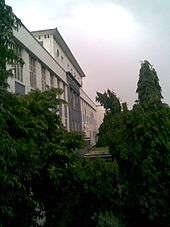Baroda Medical College
 | |
| Type | State University[1] |
|---|---|
| Established | 1949 |
| Endowment | INR 13.4 million as yearly grant from Government[2] |
| Dean | Leuva A.T, MD |
Academic staff | 318 |
| Students |
900 600 under-graduates 300 post-graduates or residents 180 students entering in 1st year MBBS each year |
| Location | Vadodara (Baroda), Gujarat, India |
| Campus | Urban |
| Website | www.medicalcollegebaroda.edu.in |
Medical College, Baroda is a medical educational institution for undergraduate and postgraduate medical studies under the Faculty of Medicine of Maharaja Sayajirao University of Baroda. It is located in the Raopura area at Vadodara, India. It is primarily affiliated with Sir Sayajirao General Hospital. The college was established in 1949.

History
Envisaged by the late His Highness Sir Sayajirao Gaekwad III as a seat of learning, Medical College Baroda and Shri Sayajirao General (SSG) Hospital was founded in the city of Vadodara by the late Maharaja of Baroda, Major General Sir Pratapsingh Gaekwad January 1946. Due to the efforts of Dr. Jivraj Mehta, the then Advisor to Government of India and Bombay State on Baroda matters, the ground floor was completed in 1949. Dr. M. D. D. Guilder, the Health Minister of Bombay State, inaugurated it on 16 June 1949. The first class was 40 students.
For initial development, the institute was entrusted to the late D. A. N. Deodars – the first Dean and Medical Superintendent of S. S. G. Hospital. The first final MBBS examination was held in April 1954. The Medical Council of India and General Medical Council of Britain recognized the degree awarded. The ruler of Baroda late Sir Sayajirao Gaekwad III initiated medical aid to the public of Baroda by starting a few bedded hospital – Dufferin hospital at Varasia in 1865. That hospital was later expanded to the present S. S. G. Hospital with a capacity of 1500 admissions.
The medical college houses the Departments of Medicine, Social and Preventive Medicine, Biochemistry, Microbiology, Physiology, Anatomy, Pathology, Pharmacology, Forensic medicine, Blood bank, Cytogenetic Laboratory and Ayurvedic Research Unit. Encircling the main college buildings there are separate buildings which house the postmortem room, the physiotherapy college, Departments of Surgery, Pediatrics, Orthopedic, Skin & V. D., Psychiatry and Obstetrics and Gynecology, Radiology, Radiotherapy and Urology.
Admissions
The college follows a quota system in the admission. Annual intake is 180 students who usually start in September. Out of the total, about 15% come after passing the All India Entrance Examination, 49% from the combined reservation for Scheduled Castes, Scheduled Tribes, Socially and Educationally Backward Castes while 2% seats are reserved for students with disabilities. The rest are from Gujarat State and the Central Board and as per merit calculated from marks obtained in Board examination.
Medical College:-
- First MBBS 1 year duration
- Anatomy, Biochemistry, Physiology, Preventive and Social Medicine (PSM)
- Second MBBS 1½ years duration
- Pathology, Microbiology, Pharmacology, Forensic medicine, PSM
- Third MBBS 2 years duration
- Medicine and allied, Surgery and allied, Obstetrics & Gynecology, Pediatrics, PSM
From the second MBBS i.e. the third semester, the students rotate through clinical branches for 142 weeks. A year after the beginning of the third MBBS, the part – 1 examinations in ENT, Ophthalmology, and PSM subjects are taken.
Passing in the second MBBS is essential for appearing in the Part 1 – third MBBS and passing in the part- I of the third MBBS is essential for appearing in part- II of the third MBBS. This part includes Medicine, Surgery Orthopedics, Pediatrics and Obstetrics & Gynecology. This is followed by one year of rotating internship
Alumni
- Nikhil C. Munshi, 1981 graduate, professor at Harvard Medical School and working on multiple myeloma cancer research at Dana-Farber Cancer Institute, recipient of year 2010 Dr. BC Roy award[3]
- Jasubhai Keshubhai Desai, M.D., (a/k/a Jasu Desai)[4] Michigan doctor finally convicted in 2013 of first degree murder in the 1983 contract killing of his business partner Anna Marie Turetzky. Dr. Desai is now serving a life sentence in Macomb Correctional Facility in Lenox Township, Michigan[5] following a protracted legal battle that saw his conviction overturned and reinstated several times and which, at thirty years, is the longest running murder case in Wayne County, Michigan history.[6][7][8][9][10][11] The saga and its impact on the families involved has also been followed in detail by the Detroit Free Press.[12]
References
- ↑ "List of Universities in Gujarat". University Grants Commission of India. Archived from the original on 8 June 2007. Retrieved 27 June 2007.
- ↑ "About MCB". Retrieved 21 April 2005.
- ↑ "Press Releases Detail - The President of India". presidentofindia.nic.in. Retrieved 2016-07-17.
- ↑ "Archived copy". Archived from the original on 22 February 2014. Retrieved 2014-02-18.
- ↑ http://mdocweb.state.mi.us/OTIS2/otis2profile.aspx?mdocNumber=380847
- ↑ http://www.freep.com/article/20120801/NEWS02/120801044/Jasubai-Desai-Ann-Marie-Turetzky-conviction-overturned
- ↑ http://www.thenewsherald.com/articles/2013/02/21/news/doc5123a2290a5a2813180953.txt
- ↑ http://www.ca6.uscourts.gov/opinions.pdf/08a0296p-06.pdf
- ↑ "Archived copy". Archived from the original on 22 February 2014. Retrieved 2014-02-18.
- ↑ http://www.freep.com/article/20120701/NEWS05/207010494/Key-dates-case
- ↑ http://docs.justia.com/cases/federal/appellate-courts/ca6/12-2050/12-2050-2013-10-09.pdf
- ↑ http://www.freep.com/article/20120703/NEWS01/207030368/A-murder-in-Woodhaven-On-opposite-sides-two-daughters-seek-justice-and-peace
External links
Coordinates: 22°18′16″N 73°11′31″E / 22.3045°N 73.1919°E